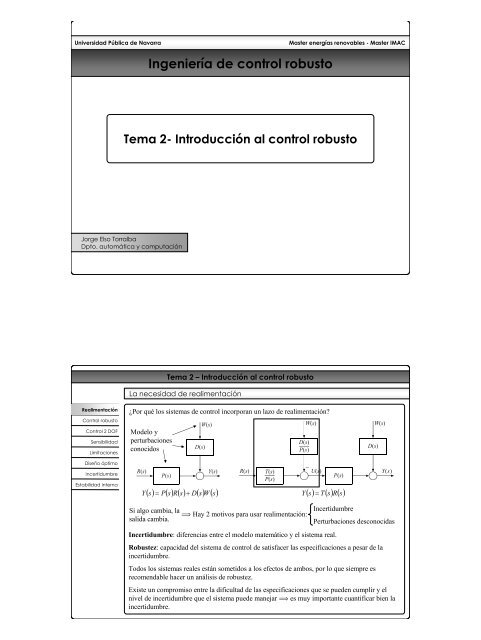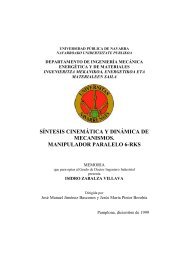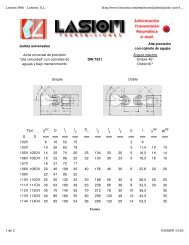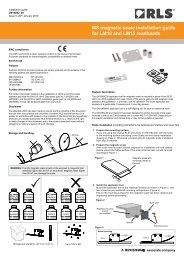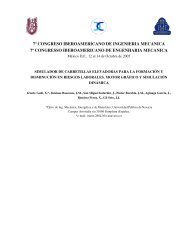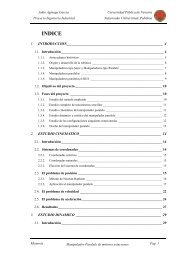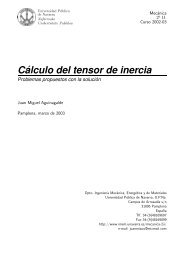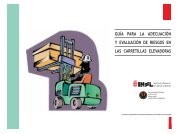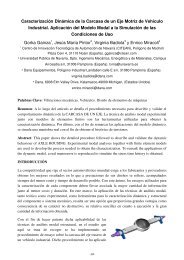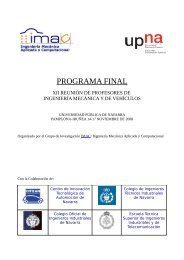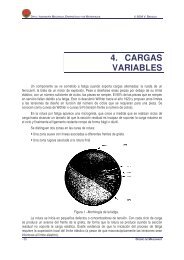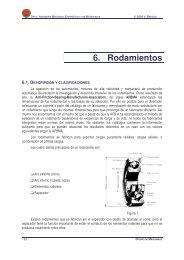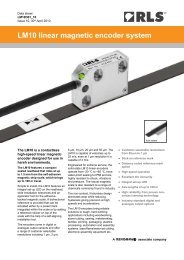Tema 2: Introducción al control robusto - Universidad Pública de ...
Tema 2: Introducción al control robusto - Universidad Pública de ...
Tema 2: Introducción al control robusto - Universidad Pública de ...
You also want an ePaper? Increase the reach of your titles
YUMPU automatically turns print PDFs into web optimized ePapers that Google loves.
<strong>Universidad</strong> Pública <strong>de</strong> Navarra<br />
<strong>Tema</strong> 2 – Introducción <strong>al</strong> <strong>control</strong> <strong>robusto</strong><br />
Master energías renovables - Master IMAC<br />
Ingeniería <strong>de</strong> <strong>control</strong> <strong>robusto</strong><br />
<strong>Tema</strong> 2- Introducción <strong>al</strong> <strong>control</strong> <strong>robusto</strong><br />
Jorge Elso Torr<strong>al</strong>ba<br />
Dpto. automática y computación<br />
<strong>Tema</strong> 2 – Introducción <strong>al</strong> <strong>control</strong> <strong>robusto</strong><br />
La necesidad <strong>de</strong> re<strong>al</strong>imentación<br />
Re<strong>al</strong>imentación<br />
Control <strong>robusto</strong><br />
Control 2 DOF<br />
Sensibilidad<br />
Limitaciones<br />
¿Por qué los sistemas <strong>de</strong> <strong>control</strong> incorporan un lazo <strong>de</strong> re<strong>al</strong>imentación?<br />
W(s)<br />
W(s)<br />
Mo<strong>de</strong>lo y<br />
perturbaciones<br />
D(s)<br />
conocidos<br />
D(s)<br />
P(s)<br />
D(s)<br />
W(s)<br />
Diseño óptimo<br />
Incertidumbre<br />
Estabilidad interna<br />
R(s)<br />
Y(s)<br />
P(s)<br />
() s = P() s R() s D( s) W ( s)<br />
Y +<br />
R(s)<br />
T(s)<br />
P(s)<br />
- U(s)<br />
P(s)<br />
( s) T ( s) R( s)<br />
Y =<br />
Y(s)<br />
Si <strong>al</strong>go cambia, la<br />
s<strong>al</strong>ida cambia.<br />
ï Hay 2 motivos para usar re<strong>al</strong>imentación:<br />
Incertidumbre<br />
Perturbaciones <strong>de</strong>sconocidas<br />
Incertidumbre: diferencias entre el mo<strong>de</strong>lo matemático y el sistema re<strong>al</strong>.<br />
Robustez: capacidad <strong>de</strong>l sistema <strong>de</strong> <strong>control</strong> <strong>de</strong> satisfacer las especificaciones a pesar <strong>de</strong> la<br />
incertidumbre.<br />
Todos los sistemas re<strong>al</strong>es están sometidos a los efectos <strong>de</strong> ambos, por lo que siempre es<br />
recomendable hacer un análisis <strong>de</strong> robustez.<br />
Existe un compromiso entre la dificultad <strong>de</strong> las especificaciones que se pue<strong>de</strong>n cumplir y el<br />
nivel <strong>de</strong> incertidumbre que el sistema pue<strong>de</strong> manejar ï es muy importante cuantificar bien la<br />
incertidumbre.
<strong>Tema</strong> 2 – Introducción <strong>al</strong> <strong>control</strong> <strong>robusto</strong><br />
El problema <strong>de</strong> <strong>control</strong> <strong>robusto</strong><br />
Re<strong>al</strong>imentación<br />
Control <strong>robusto</strong><br />
Control 2 DOF<br />
Sensibilidad<br />
Limitaciones<br />
Diseño óptimo<br />
Incertidumbre<br />
Estabilidad interna<br />
El problema gener<strong>al</strong> <strong>de</strong> <strong>control</strong> automático es<br />
w<br />
r<br />
u<br />
y<br />
<strong>control</strong>ador<br />
planta<br />
v<br />
sensor<br />
n<br />
Dado un sistema o planta, un conjunto <strong>de</strong><br />
señ<strong>al</strong>es <strong>de</strong> s<strong>al</strong>ida medidas v, <strong>de</strong>terminar<br />
qué acciones <strong>de</strong> <strong>control</strong> u <strong>de</strong>ben re<strong>al</strong>izarse<br />
para que las variables <strong>control</strong>adas y sigan<br />
lo mejor posible a las señ<strong>al</strong>es <strong>de</strong> referencia<br />
r, a pesar <strong>de</strong> la influencia <strong>de</strong> perturbaciones<br />
w y ruido <strong>de</strong> medida n.<br />
‣ El sistema pue<strong>de</strong> estar mo<strong>de</strong>lado por ecuaciones diferenci<strong>al</strong>es line<strong>al</strong>es, no line<strong>al</strong>es, <strong>de</strong><br />
parámetros concentrados o distribuidos, etc.<br />
‣ Por otro lado, pue<strong>de</strong>n existir no line<strong>al</strong>ida<strong>de</strong>s tipo saturación, zona muerta, cuantización, etc,<br />
tanto en los sensores como en los actuadores (que se consi<strong>de</strong>ran parte <strong>de</strong> la planta).<br />
‣Pue<strong>de</strong>n ser establecidos límites en las acciones <strong>de</strong> <strong>control</strong> permitidas.<br />
‣El mo<strong>de</strong>lo disponible no <strong>de</strong>scribe perfectamente <strong>al</strong> sistema, y a<strong>de</strong>más éste varía con el tiempo.<br />
Objetivo <strong>de</strong>l <strong>control</strong> <strong>robusto</strong>: hacer que todas las posibles s<strong>al</strong>idas <strong>de</strong> las diferentes plantas <strong>de</strong>ntro<br />
<strong>de</strong> la incertidumbre pertenezcan a un conjunto <strong>de</strong> s<strong>al</strong>idas aceptables.<br />
El problema <strong>de</strong> <strong>control</strong> <strong>robusto</strong> se suele afrontar <strong>de</strong>s<strong>de</strong> los métodos <strong>de</strong> respuesta frecuenci<strong>al</strong>.<br />
<strong>Tema</strong> 2 – Introducción <strong>al</strong> <strong>control</strong> <strong>robusto</strong><br />
Sistemas <strong>de</strong> <strong>control</strong> con dos grados <strong>de</strong> libertad<br />
Re<strong>al</strong>imentación<br />
Control <strong>robusto</strong><br />
Control 2 DOF<br />
Sensibilidad<br />
Ejemplos <strong>de</strong> esquemas <strong>de</strong> dos grados <strong>de</strong> libertad:<br />
1<br />
R(s) + E(s) 1 +<br />
U(s) Y(s)<br />
K<br />
P(s)<br />
R(s) + E(s) 1 + +<br />
TIs<br />
U(s) Y(s)<br />
-<br />
K<br />
P(s)<br />
TIs<br />
-<br />
+ +<br />
Limitaciones<br />
Diseño óptimo<br />
TDs<br />
PI-D<br />
1 TDs<br />
I-PD<br />
Incertidumbre<br />
C 2(s)<br />
Estabilidad interna<br />
+<br />
-<br />
C 1(s)<br />
+ +<br />
H(s)<br />
P (s)<br />
Feed-forward<br />
Todos los esquemas se<br />
pue<strong>de</strong>n reducir <strong>al</strong> gener<strong>al</strong><br />
Esquema <strong>de</strong> dos grados <strong>de</strong> libertad gener<strong>al</strong>:<br />
Controlador <strong>de</strong> re<strong>al</strong>imentación: reduce <strong>de</strong> los efectos<br />
<strong>de</strong> las perturbaciones y <strong>de</strong> la incertidumbre<br />
W(s)<br />
D(s)<br />
Prefiltro: acomoda la<br />
señ<strong>al</strong> <strong>de</strong> entrada para<br />
mejorar el seguimiento<br />
<strong>de</strong> referencia<br />
R(s)<br />
F(s)<br />
E(s)<br />
-<br />
C(s)<br />
U(s)<br />
H(s)<br />
P(s)<br />
Y(s)<br />
N(s)<br />
El <strong>control</strong>ador i<strong>de</strong><strong>al</strong> para rechazo <strong>de</strong> perturbaciones es distinto <strong>de</strong>l <strong>control</strong>ador i<strong>de</strong><strong>al</strong> para<br />
seguimiento <strong>de</strong> referencia ï se recurre a un esquema <strong>de</strong> dos grados <strong>de</strong> libertad.
<strong>Tema</strong> 2 – Introducción <strong>al</strong> <strong>control</strong> <strong>robusto</strong><br />
La función <strong>de</strong> sensibilidad y la re<strong>al</strong>imentación<br />
Re<strong>al</strong>imentación<br />
Control <strong>robusto</strong><br />
Control 2 DOF<br />
Sensibilidad<br />
Limitaciones<br />
Diseño óptimo<br />
Incertidumbre<br />
Estabilidad interna<br />
¿Cómo logra la re<strong>al</strong>imentación atenuar los efectos <strong>de</strong> la incertidumbre y las perturbaciones?<br />
La función <strong>de</strong> sensibilidad nos da la respuesta:<br />
∆F()<br />
s<br />
Sistema formado<br />
por la interconexión<br />
V(s)<br />
F<br />
()<br />
() s<br />
S s =<br />
A(s)<br />
<strong>de</strong> funciones <strong>de</strong><br />
∆V<br />
() s<br />
transferencia, una <strong>de</strong><br />
... ... Y(s)<br />
V () s<br />
las cu<strong>al</strong>es cambia:<br />
C(s)<br />
B(s)<br />
V<br />
()<br />
() s dF s<br />
S F , V s =<br />
F s dV s<br />
Aplicándola sobre el lazo abierto y el lazo cerrado siguientes<br />
R(s)<br />
R(s)<br />
-<br />
P(s)<br />
Y(s)<br />
P(s)<br />
H(s)<br />
Y(s)<br />
⇒ S<br />
⇒ S<br />
( s) 1<br />
T R<br />
() s<br />
, P =<br />
=<br />
T , P R 1 +<br />
1<br />
P<br />
() s H () s<br />
⎧V<br />
⎪<br />
⇒ ⎨F<br />
⎪<br />
⎩<br />
( s) = P( s)<br />
Y<br />
()<br />
() s<br />
s =<br />
R()<br />
s<br />
= T<br />
R<br />
() s<br />
()<br />
()<br />
()<br />
El lazo cerrado<br />
proporciona una<br />
reducción <strong>de</strong> la<br />
sensibilidad frente a<br />
los cambios en la<br />
planta con un factor<br />
1<br />
1+ P s H s<br />
() ()<br />
<strong>Tema</strong> 2 – Introducción <strong>al</strong> <strong>control</strong> <strong>robusto</strong><br />
Sensibilidad, lazo abierto y sensibilidad complementaria<br />
Re<strong>al</strong>imentación<br />
Control <strong>robusto</strong><br />
Control 2 DOF<br />
Sensibilidad<br />
Limitaciones<br />
Diseño óptimo<br />
Incertidumbre<br />
Estabilidad interna<br />
La función <strong>de</strong> sensibilidad <strong>de</strong> un sistema con re<strong>al</strong>imentación se refiere a la sensibilidad <strong>de</strong> la<br />
función referencia-s<strong>al</strong>ida ente variaciones en la planta.<br />
En un esquema 2 DOF gener<strong>al</strong> dicha función es<br />
S<br />
() s<br />
= 1<br />
1 + P<br />
() s C() s H () s<br />
La función <strong>de</strong> lazo abierto es el producto <strong>de</strong> todas las funciones <strong>de</strong> transferencia situadas<br />
<strong>de</strong>ntro <strong>de</strong>l lazo:<br />
() s P() s C() s H ( s)<br />
L =<br />
fl De modo gener<strong>al</strong>, la función <strong>de</strong> sensibilidad se <strong>de</strong>fine como<br />
S<br />
() s<br />
= ˆ<br />
1<br />
1 + L<br />
() s<br />
La función sensibilidad complementaria se <strong>de</strong>fine <strong>de</strong> modo similar:<br />
() s<br />
L()<br />
s<br />
L<br />
T () s = ˆ 1+<br />
El término “complementaria” proviene <strong>de</strong> la relación<br />
S<br />
() s + T() s = 1<br />
que es una <strong>de</strong> las restricciones fundament<strong>al</strong>es <strong>de</strong> todo sistema <strong>de</strong> <strong>control</strong>.
<strong>Tema</strong> 2 – Introducción <strong>al</strong> <strong>control</strong> <strong>robusto</strong><br />
Sensibilidad, lazo abierto y sensibilidad complementaria<br />
Re<strong>al</strong>imentación<br />
Control <strong>robusto</strong><br />
Control 2 DOF<br />
Sensibilidad<br />
La señ<strong>al</strong> <strong>de</strong> s<strong>al</strong>ida <strong>de</strong> un<br />
sistema 2DOF viene dada<br />
por la función<br />
R(s)<br />
F(s)<br />
E(s)<br />
-<br />
C(s)<br />
W(s)<br />
U(s)<br />
D(s)<br />
P(s)<br />
Y(s)<br />
Limitaciones<br />
Diseño óptimo<br />
Incertidumbre<br />
Estabilidad interna<br />
Y<br />
Y<br />
() s<br />
=<br />
1+<br />
P<br />
D()<br />
s<br />
() s C() s H () s<br />
W<br />
() s<br />
P<br />
+<br />
1+<br />
( s) = T ( s) W ( s) + T ( s) R( s) −T<br />
( s) N( s)<br />
W<br />
R<br />
N<br />
( s) C( s) F( s)<br />
R()<br />
s<br />
P() s C() s H () s<br />
P<br />
−<br />
1+<br />
H(s)<br />
( s) C( s) H ( s)<br />
P() s C() s H () s<br />
fl hay tres funciones <strong>de</strong> transferencia en lazo cerrado, que comparten el <strong>de</strong>nominador 1+L(s):<br />
N<br />
() s<br />
N(s)<br />
Esta ecuación pue<strong>de</strong> reescribirse en términos <strong>de</strong> las sensibilida<strong>de</strong>s:<br />
Y<br />
() s = S() s D() s W () s + T()<br />
s<br />
Conclusiones:<br />
( s)<br />
R() s −T() s N()<br />
s<br />
() s<br />
F<br />
H<br />
La transición entre<br />
estos dos<br />
<strong>de</strong>termina la<br />
estabilidad.<br />
1. La manera <strong>de</strong> disminuir el efecto <strong>de</strong> las perturbaciones es reducir S(s).<br />
2. Si se consigue T(s)º1, se pue<strong>de</strong> ajustar F(s) para tener el T R (s) <strong>de</strong>seado.<br />
3. La manera <strong>de</strong> disminuir el efecto <strong>de</strong>l ruido es reducir T(s).<br />
↑ L( jω)<br />
↓ L( jω)<br />
<strong>Tema</strong> 2 – Introducción <strong>al</strong> <strong>control</strong> <strong>robusto</strong><br />
Limitaciones: Integr<strong>al</strong> <strong>de</strong> sensibilidad<br />
Re<strong>al</strong>imentación<br />
Control <strong>robusto</strong><br />
Control 2 DOF<br />
Sensibilidad<br />
Limitaciones<br />
Diseño óptimo<br />
Incertidumbre<br />
Estabilidad interna<br />
Para cu<strong>al</strong>quier sistema <strong>de</strong> fase mínima en el que hay <strong>al</strong> menos dos polos más que ceros en lazo<br />
abierto (la mayoría <strong>de</strong> los casos re<strong>al</strong>es son así), se cumple la siguiente integr<strong>al</strong>:<br />
∫ ∞ ln S( jω) dω = 0<br />
0<br />
1<br />
0<br />
-1<br />
-2<br />
-3<br />
ln|S(jw)|<br />
Re<strong>al</strong>imentación<br />
negativa<br />
Re<strong>al</strong>imentación<br />
positiva<br />
5<br />
0<br />
-5<br />
-10<br />
-15<br />
-20<br />
-25<br />
|S(jw)| (dB)<br />
-4<br />
-30<br />
-35<br />
-5<br />
-40<br />
0 1 2 3 4 5 6 7 8 9 10 10 -2 10 -1 10 0 10 1 10 2<br />
Frequency (rad/sec)<br />
Frequency (rad/sec)<br />
Se conoce a 1/S(jw) = 1+L(jw) como función <strong>de</strong> re<strong>al</strong>imentación, y la integr<strong>al</strong> es la misma para<br />
ella. Esto nos lleva a distinguir entre áreas <strong>de</strong> re<strong>al</strong>imentación negativa y positiva.<br />
Ambas son igu<strong>al</strong>es fl si se reduce el efecto <strong>de</strong> perturbaciones e incertidumbre en una zona,<br />
entonces existe otra región en la que dicho efecto se incrementa.<br />
La re<strong>al</strong>imentación positiva se concentra cerca <strong>de</strong> la frecuencia <strong>de</strong> cruce <strong>de</strong> ganancia.
<strong>Tema</strong> 2 – Introducción <strong>al</strong> <strong>control</strong> <strong>robusto</strong><br />
El coste <strong>de</strong> la re<strong>al</strong>imentación<br />
Re<strong>al</strong>imentación<br />
Control <strong>robusto</strong><br />
Control 2 DOF<br />
Sensibilidad<br />
Limitaciones<br />
Diseño óptimo<br />
Incertidumbre<br />
Estabilidad interna<br />
C() s H () s −1<br />
=<br />
() s C() s H () s P()<br />
s<br />
−<br />
L<br />
T UN () s =<br />
1+<br />
P<br />
1+<br />
L<br />
1<br />
( s)<br />
L()<br />
s<br />
3 rangos:<br />
( jω)<br />
>> 1<br />
( jω)<br />
≈ 1<br />
( jω) > 1⇒<br />
TUN<br />
( jω)<br />
≈<br />
( jω)
<strong>Tema</strong> 2 – Introducción <strong>al</strong> <strong>control</strong> <strong>robusto</strong><br />
Origen <strong>de</strong> la incertidumbre<br />
Re<strong>al</strong>imentación<br />
Control <strong>robusto</strong><br />
Control 2 DOF<br />
Sensibilidad<br />
Limitaciones<br />
Diseño óptimo<br />
Incertidumbre<br />
El trabajo <strong>de</strong> análisis y diseño <strong>de</strong>l ingeniero se re<strong>al</strong>iza sobre el mo<strong>de</strong>lo <strong>de</strong>l sistema.<br />
El mo<strong>de</strong>lo nunca <strong>de</strong>scribe<br />
completamente el comportamiento<br />
<strong>de</strong>l sistema ï hay incertidumbre.<br />
Incapacidad <strong>de</strong> llegar a un<br />
mo<strong>de</strong>lo perfecto<br />
Eliminación <strong>de</strong>liberada <strong>de</strong><br />
aspectos <strong>de</strong>l mo<strong>de</strong>lo<br />
Estabilidad interna<br />
Tarea <strong>de</strong>l diseñador<br />
Definir el conjunto <strong>de</strong> todas las<br />
posibles plantas que pue<strong>de</strong>n <strong>de</strong>scribir<br />
<strong>al</strong> sistema en un momento dado<br />
¿Qué sabemos sobre lo<br />
que no conocemos?<br />
Fuentes <strong>de</strong> incertidumbre:<br />
1. Medición <strong>de</strong> los parámetros físicos<br />
2. Cambio en los parámetros físicos, por condiciones ambient<strong>al</strong>es, envejecimiento, …<br />
3. Line<strong>al</strong>ización <strong>de</strong> la planta<br />
4. Sensores y actuadores<br />
5. Altas frecuencias ï estructura y or<strong>de</strong>n <strong>de</strong>l mo<strong>de</strong>lo <strong>de</strong>sconocidos<br />
6. Dinámica ignorada para simplificar el diseño<br />
<strong>Tema</strong> 2 – Introducción <strong>al</strong> <strong>control</strong> <strong>robusto</strong><br />
Tipos <strong>de</strong> incertidumbre<br />
Re<strong>al</strong>imentación<br />
Control <strong>robusto</strong><br />
Control 2 DOF<br />
Sensibilidad<br />
Limitaciones<br />
Diseño óptimo<br />
Incertidumbre<br />
Estabilidad interna<br />
De acuerdo con su origen, la incertidumbre se pue<strong>de</strong> separar en dos categorías<br />
1) Incertidumbre paramétrica o estructurada.<br />
‣ Estructura conocida<br />
‣ Parámetros pertenecientes a interv<strong>al</strong>os<br />
P<br />
m<br />
( α , s) , α ∈ Ω ∈ <br />
( α , s) ∈ P( α s)<br />
Cada α i ∈ Ω genera un P i ,<br />
z<br />
z<br />
W<br />
z<br />
a<br />
wn<br />
wn<br />
wn<br />
Ejemplo<br />
P<br />
n<br />
( α,<br />
s) =<br />
;<br />
k ∈<br />
2<br />
2<br />
kω<br />
n<br />
2<br />
n<br />
s + 2ζω<br />
s + ω<br />
[ k, k] ; ζ ∈[ ζ , ζ ];<br />
ω ∈[ ω , ω ]<br />
n<br />
n<br />
n<br />
k<br />
k<br />
Otra forma <strong>de</strong> presentar incertidumbre estructurada es simplemente dar un conjunto <strong>de</strong> posibles<br />
plantas, sin <strong>de</strong>finir explícitamente interv<strong>al</strong>os <strong>de</strong> variación <strong>de</strong> los parámetros.<br />
V<strong>al</strong>or <strong>de</strong> referencia <strong>de</strong> los parámetros<br />
Planta nomin<strong>al</strong> P 0 (s)<br />
Las <strong>de</strong>más plantas se interpretan como<br />
<strong>de</strong>sviaciones respecto a la nomin<strong>al</strong>.
<strong>Tema</strong> 2 – Introducción <strong>al</strong> <strong>control</strong> <strong>robusto</strong><br />
Tipos <strong>de</strong> incertidumbre<br />
Re<strong>al</strong>imentación<br />
Control <strong>robusto</strong><br />
Control 2 DOF<br />
Sensibilidad<br />
Limitaciones<br />
2) Incertidumbre no paramétrica o no estructurada.<br />
P(s)<br />
WI(s) DI(s)<br />
P<br />
Planta nomin<strong>al</strong><br />
( s) = P ( s) ( 1+ W ( s) ∆ ( s)<br />
)<br />
0<br />
I<br />
I<br />
Diseño óptimo<br />
P0(s)<br />
Incertidumbre<br />
Estabilidad interna<br />
Incertidumbre multiplicativa<br />
Función <strong>de</strong> peso:<br />
representa el nivel<br />
<strong>de</strong> incertidumbre<br />
en cada frecuencia<br />
Cu<strong>al</strong>quier función<br />
que cumple<br />
( jω) ≤ ∀ω<br />
∆ 1<br />
I<br />
‣ Es más difícil <strong>de</strong> cuantificar<br />
‣ Lleva a resultados más conservadores<br />
‣ Es la única que se pue<strong>de</strong> emplear en <strong>al</strong>tas frecuencias<br />
¿Cuál <strong>de</strong> ellas usar? Depen<strong>de</strong> <strong>de</strong> la técnica <strong>de</strong> <strong>control</strong> <strong>robusto</strong> que utilicemos:<br />
QFT ö Permite el uso <strong>de</strong> ambas<br />
H , m análisis, etc ö Incertidumbre no paramétrica<br />
<strong>Tema</strong> 2 – Introducción <strong>al</strong> <strong>control</strong> <strong>robusto</strong><br />
Estabilidad y estabilidad interna<br />
Re<strong>al</strong>imentación<br />
Control <strong>robusto</strong><br />
Control 2 DOF<br />
Sensibilidad<br />
Limitaciones<br />
Diseño óptimo<br />
Incertidumbre<br />
Estabilidad interna<br />
Sabemos que la estabilidad <strong>de</strong> un sistema viene dada por la posición <strong>de</strong> los ceros <strong>de</strong> la ecuación<br />
característica, que es el <strong>de</strong>nominador <strong>de</strong> todas las funciones <strong>de</strong> transferencia <strong>de</strong> lazo cerrado.<br />
Por ejemplo, la sensibilidad complementaria: T<br />
Criterios <strong>de</strong><br />
estabilidad<br />
‣Routh-Hurwitz<br />
‣ Lugar <strong>de</strong> raíces<br />
() s<br />
‣ Criterio <strong>de</strong> Nyquist ö MG, MF<br />
P<br />
= 1+<br />
( s) C( s) H ( s)<br />
P() s C() s H () s<br />
Nos dicen si hay polos <strong>de</strong> T(s)<br />
en el RHP, basándose en L(s)<br />
Pero esos criterios no son suficientes:<br />
R(s)<br />
T<br />
-<br />
1<br />
= s + 2<br />
1<br />
(s-1)<br />
() s ;<br />
U(s) (s-1) Y(s) 1. La cancelación perfecta es<br />
(s+1)<br />
U<br />
R<br />
( s)<br />
s + 1<br />
=<br />
() s ( s −1)( s + 2)<br />
imposible, pero aunque así fuera,<br />
2. u(t) crece sin cota, lo que en la<br />
práctica satura los actuadores.<br />
Es un problema <strong>de</strong> estabilidad interna: presencia <strong>de</strong> modos ocultos inestables.<br />
Un sistema es internamente estable si cumple el criterio <strong>de</strong> estabilidad <strong>de</strong> Nyquist, y a<strong>de</strong>más,<br />
no se producen cancelaciones cero-polo en el RHP entre ninguno <strong>de</strong> los elementos <strong>de</strong> L(s).<br />
Si lo anterior se cumple para todos los miembros <strong>de</strong> P, hablamos <strong>de</strong> estabilidad robusta.


